All products featured are independently chosen by us. However, SoundGuys may receive a commission on orders placed through its retail links. See our ethics statement.
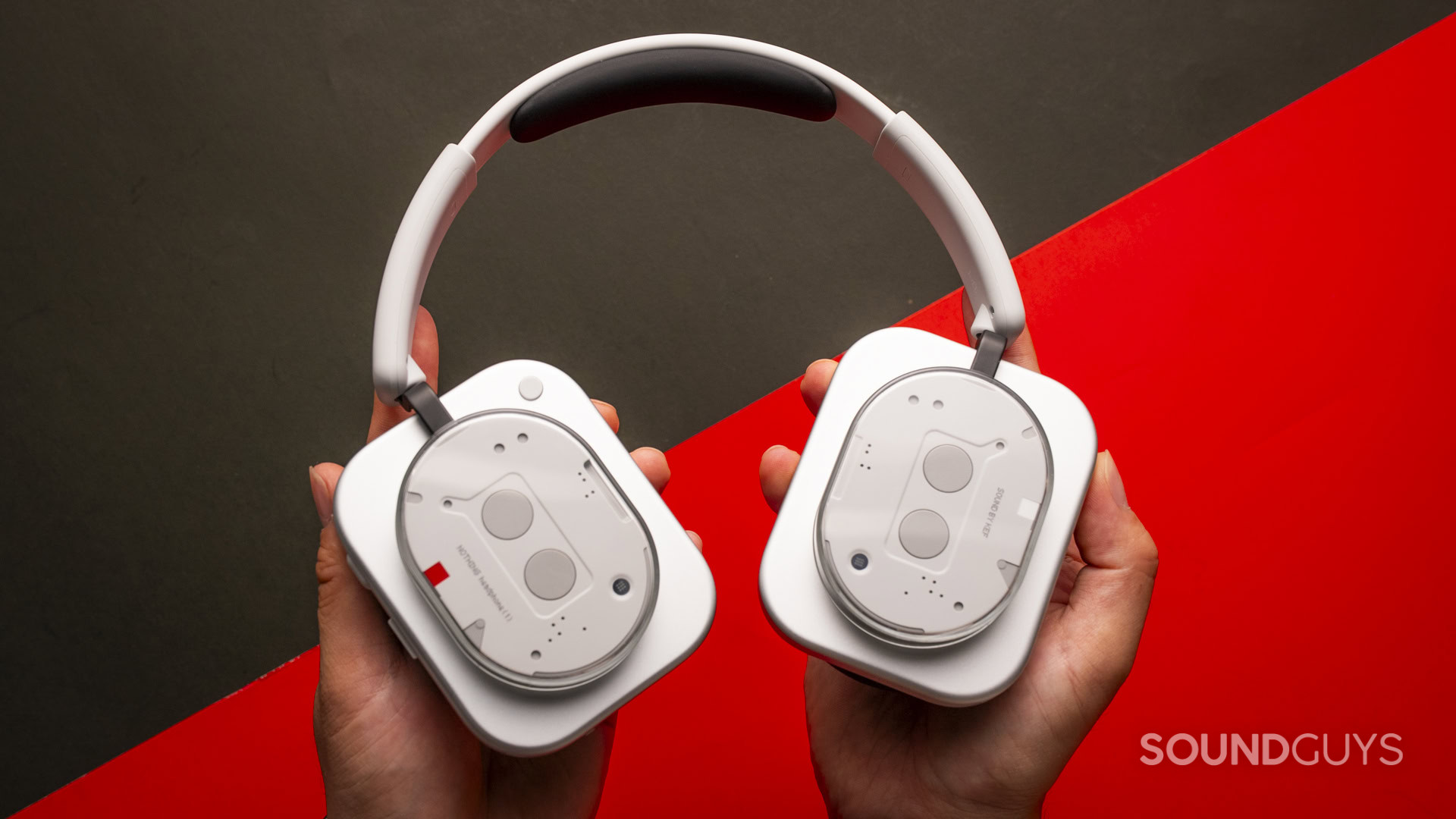

Nothing Headphone (1) review: Something different
July 11, 2025


Nothing Headphone 1
Weight: 329g
Nothing has built a solid reputation in the audio space since launching its first true wireless earbuds in 2021. The London-based company is now on its third iteration of the flagship Ear, while its sub-brand CMF is cranking out a second-generation lineup of budget-friendly buds that punch above their weight. Now, Nothing is applying its philosophy of simplicity and transparency to its first attempt at over-ear headphones, aptly named the Headphone (1). Is it enough to compete in a crowded market dominated by Sony, Bose, and Apple? We took them to the lab to find out.
- This article was updated on July 11, 2025, to embed our video review.
- This article was updated on July 9, 2025, to share the QR code for our advanced equalizer sound profile.
- This article was updated on July 7, 2025, to add our battery test results.
What’s it like to use the Nothing Headphones (1)?
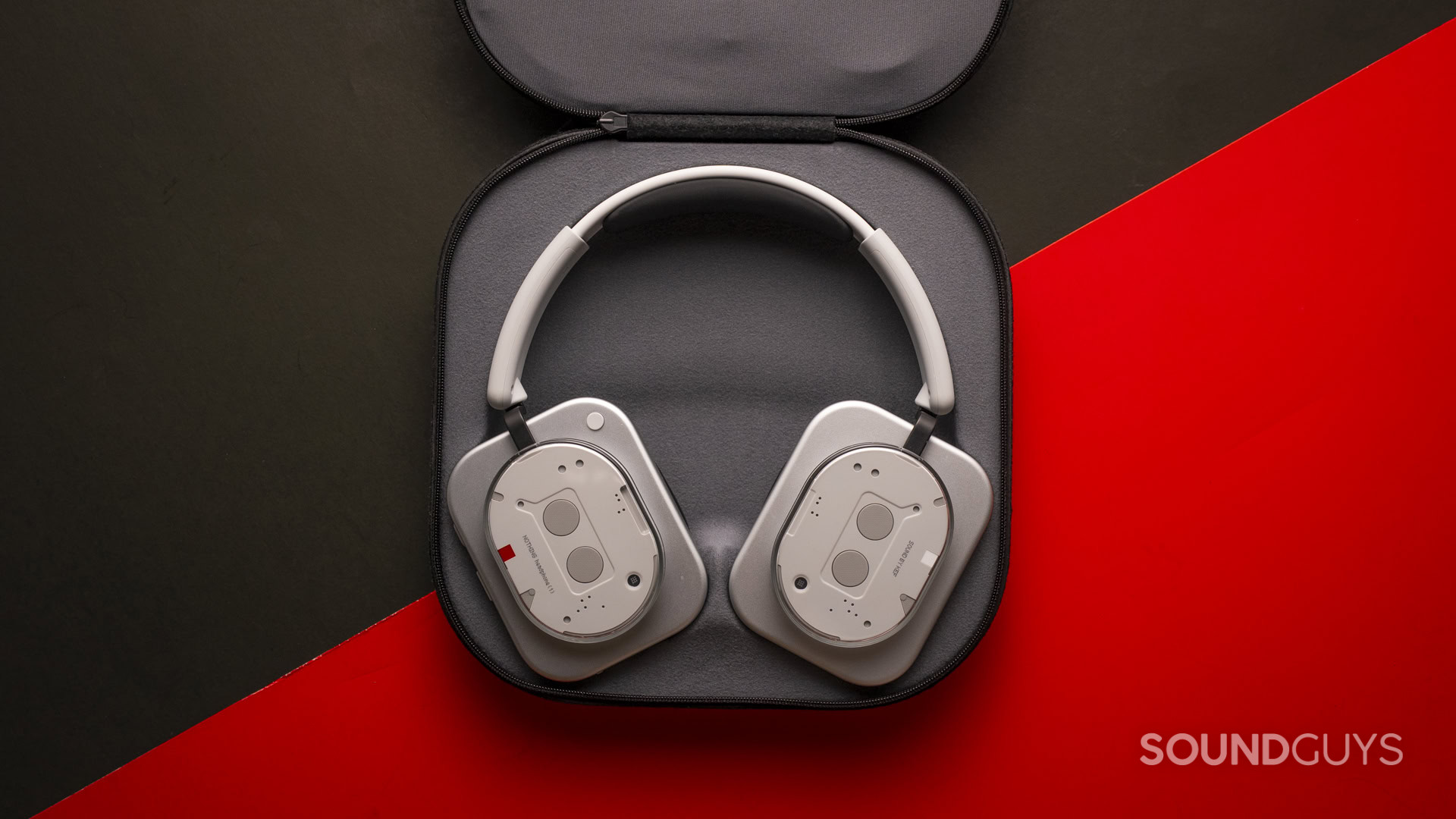
The Nothing Headphone (1) doesn’t look like any headphones I’ve ever seen, combining square aluminum slabs topped with rounded see-through plastic that reveals some internal gadgetry, mostly random parts and pieces that look cool, not actual internal working components. They sorta look like a mix of classic Nintendo and Sony Walkman hardware. Wearing them while walking down the street provoked many curious looks and even a few inquiries about what was on my head. Nothing has made something that sure stands out, but it isn’t just for show, as the build quality feels solid and premium.
These headphones are conversation starters that blend retro-tech style with modern features.
While these headphones are somewhat weighty in hand, I found them quite comfortable to wear for hours at a time. The clamping force provides a secure fit without being too tight, and the memory foam ear cushions create a cozy seal that softens with use over time to fit the shape of your head. The inside of the ear cups are also padded, so you don’t have to worry about any plastic parts poking your ears. You get the same material in the headband padding, with more ample cushioning to distribute weight more evenly than you will find on the likes of the Sony WH-1000XM6.
One downside to the rectangular shape is that the corners can collide with each other while handling the headphones, especially while wearing them around your neck. I did get a few dings during my usage, and I worry about cosmetic wear over time.
Nothing includes a softshell carry case featuring familiar design elements. For example, there’s an indentation for your thumb in the top right corner, similar to the Nothing Ear’s case. The zipper strap is a little thin and can easily get caught if pulled at an angle and not straight out while trying to open the case. The case itself provides adequate protection and has a pouch for spare cables, but because headphones can’t fold up and only rotate to lay flat, they will maintain their full size during transport.
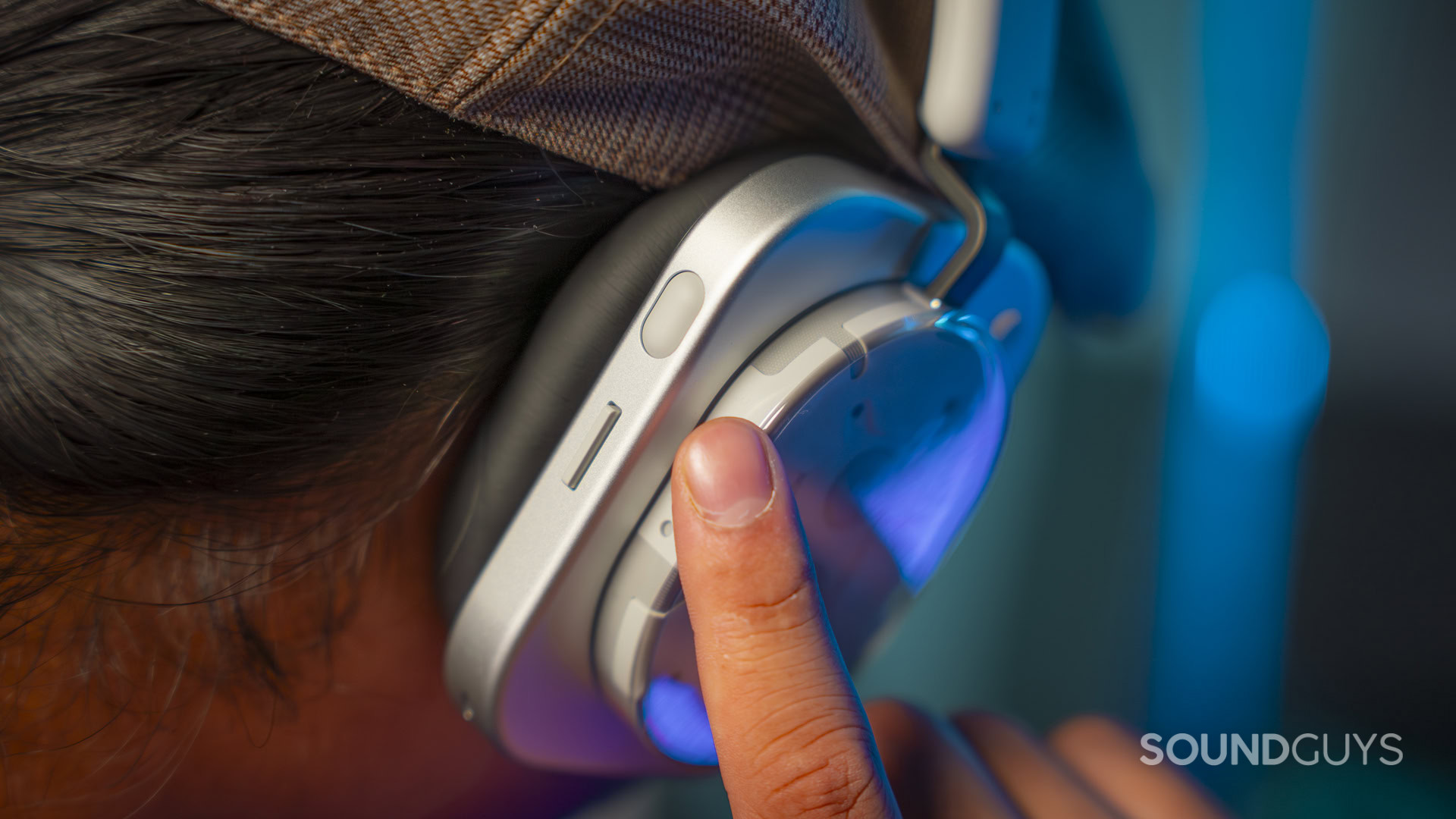
The tactile control system is one of my favorite aspects of the Headphones (1). As the resident gaming headset reviewer, I’m used to things like knobs and volume dials; I am happy to see physical input make a return to flagship headphones over the now-popular touch-sensitive surfaces, which I often find finicky. On the back of the right earcup, there’s a rubbery roller that you can swipe left or right with your thumb to adjust the volume, producing satisfying clicking sound effects. Then there’s the paddle, which is pretty unique and intuitive; this little rocker switch lets you skip tracks with a quick press in either direction or hold it down to scrub through songs in 10-second increments.
The physical controls are fun and easy to use.
A small circular multifunction button on the outside surface completes the control trio and is the only one you can assign different commands within the Nothing X app. You can customize it to trigger your voice assistant, cycle through noise cancelation modes, or enable spatial audio. Better yet, you can assign a second function activated by holding the button, giving you quick access to two features without digging through menus. Nothing phone users get additional perks like Essential Space for voice notes and Channel Hop for switching between audio apps. However, the latter only works with the new Nothing Phone (3), which is disappointing, as many are left out.
What are the best features of the Nothing Headphones (1)?
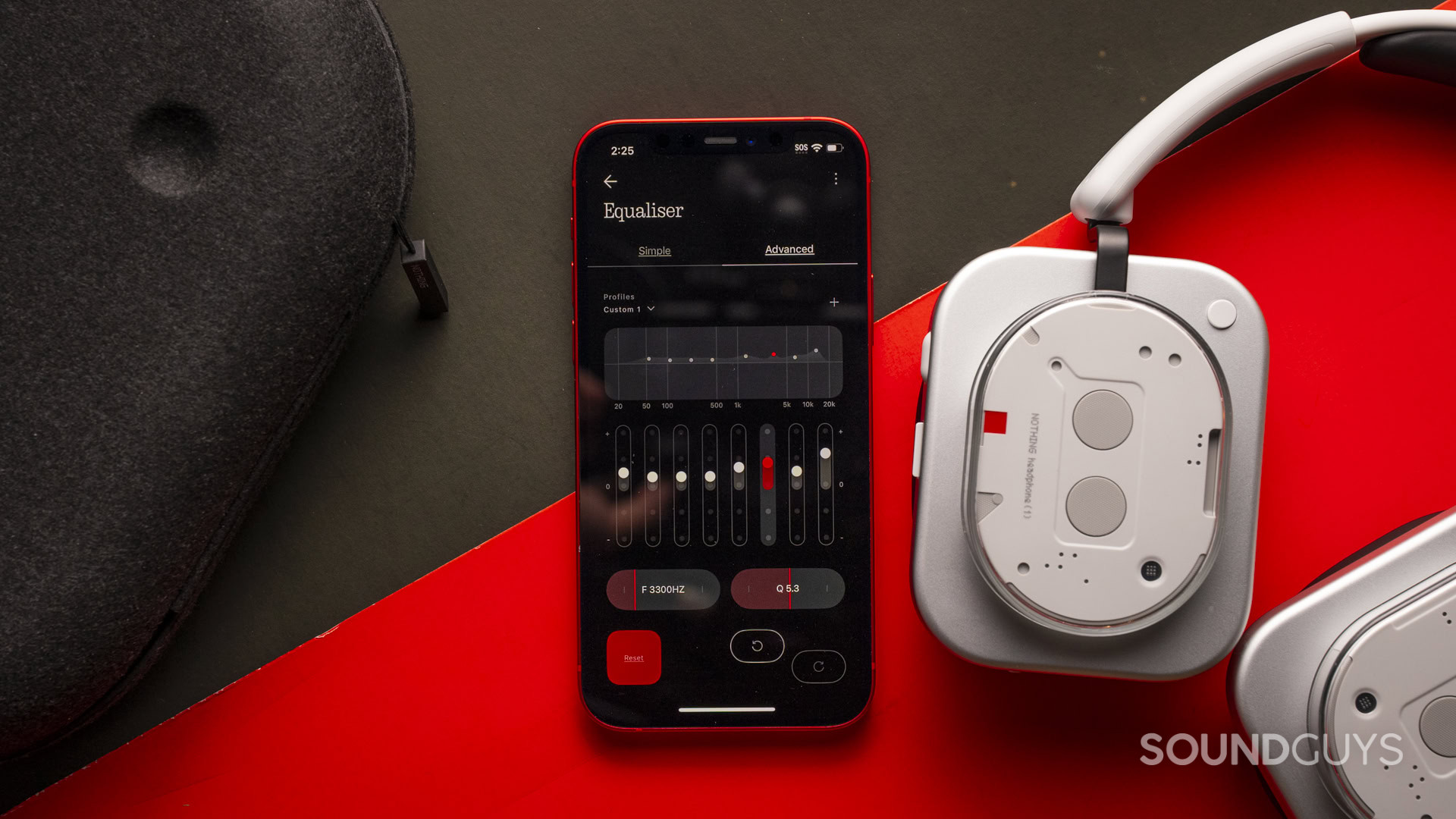
While the Nothing Headphones (1) certainly stand out visually from the crowded premium over-ear market, a few features under the hood also differentiate them. For starters, headphones sport an IP52 water and dust resistance rating—something virtually unheard of in this category. While flagship models from Sony, Bose, and Apple lack water protection whatsoever, Nothing’s cans can handle gym sessions, light rain, and sweaty commutes without concern. This alone makes them uniquely practical for active users.
The Nothing X companion app unlocks the headphones’ full potential with comprehensive customization options. My favorite feature is the 8-band custom equalizer that lets you adjust both frequency and Q factor (bandwidth) for each band. This level of control typically requires dedicated audio software, not a headphone app. Each band offers ±6dB of adjustment, and there’s even a separate 5-level bass enhancer for those who want extra low-end without touching the main EQ.
The advanced 8-band custom equalizer is essential.
For less technical users, four presets (Balanced, More Bass, More Treble, Voice) cover other listening preferences, but there’s also a simpler tri-band equalizer for quick adjustments. EQ presets are stored locally to the headphones, too, so they will sound how you like, no matter which device you use them with. You can even generate QR codes to share your custom EQ sound profiles with others and import presets by scanning codes. Nothing even adds nine different genre-themed QR code designs, adding a fun visual element.
The app also handles spatial audio with head tracking, transforming stereo content into immersive surround sound. Like Apple’s, Bose’s, and Sony’s spatial audio, it locks your position while listening to audio and rotates the panning according to how you turn your head. Frankly, I found this feature worked better with movies and gaming than with music.
Curiously, there is no hearing test to create a custom sound profile, as found with the Nothing Ear or CMF Buds 2 Plus. I missed this feature and think the tuning of these headphones could have benefited from it, but more on that later.
How does the Nothing Headphones (1) connect?
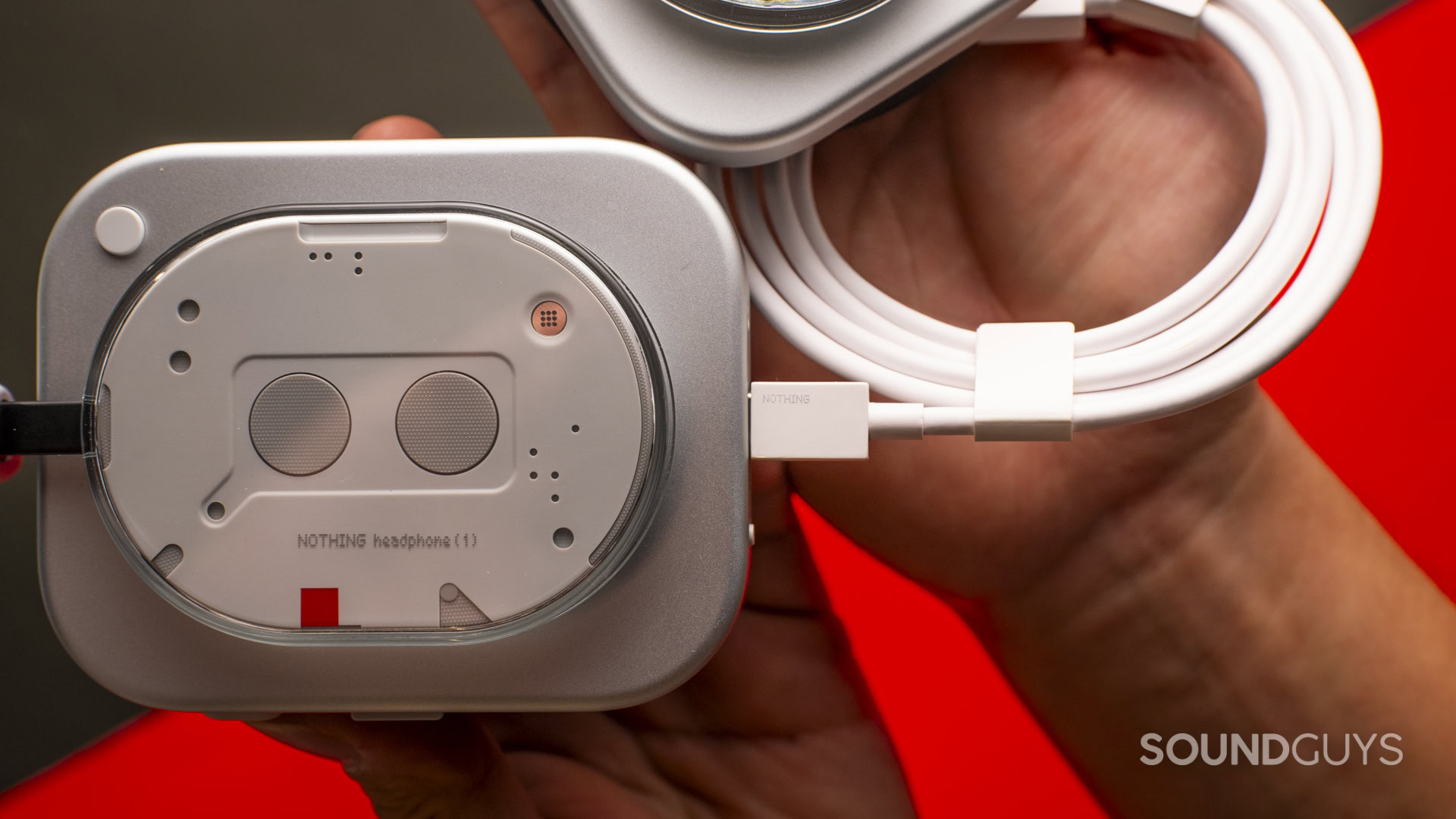
The Nothing Headphone (1) uses Bluetooth 5.3 with a 10-meter range and supports dual-device connection to switch between two paired devices quickly. For wireless audio, you get SBC, AAC, and LDAC codec support—the latter enabling high-resolution wireless audio up to 24-bit/96kHz on compatible Android devices.
For wired listening, Nothing includes both USB-C audio and a 3.5mm headphone jack with cables in the box. The USB-C connection is particularly useful for modern smartphones and can deliver digital audio that bypasses your device’s DAC. Setup is streamlined with Google Fast Pair and Microsoft Swift Pair support, though the Bluetooth pairing button inside the right ear cup is somewhat small and hard to find, at least while wearing the headphones. The Nothing X app also includes a low-latency gaming mode to reduce audio delay during video playback and gaming.
Follow the steps below to pair the Nothing Headphones (1):
- Turn on the headphones by pressing and holding the power button
- Press and hold the Bluetooth pairing button (located inside the right ear cup) until you hear the pairing prompt
- On your device, select “Nothing Headphone (1)” from the available Bluetooth devices list
- For Android devices with Google Fast Pair or Windows devices with Swift Pair, follow any on-screen prompts for quicker setup.
How long does the Nothing Headphone (1)’s battery last?
In our testing, the Nothing Headphone (1) lasted 42 hours and 53 minutes with ANC on, exceeding the manufacturer’s claim of 35 hours. The results make sense, as the 35-hour estimate was likely based on playing the headphones at 50% volume, while we tested at around 38%. Without ANC, the Headphone (1) is rated to last up to 80 hours. Your mileage will vary depending on how loud you like to listen to music and how often you use ANC.
For context, the Nothing Headphone (1)’s battery life is longer than that of the Sony WH-1000XM5, Bose QuietComfort Ultra, and Apple AirPods Max, which enjoy roughly 20-30 hours of ANC-enabled playtime.
Yes. According to Nothing, fast charging provides 5 hours of ANC-off playback from just 5 minutes of charging. That is far better than some competitors, such as the Bose QuietComfort Ultra, which only provides two and a half hours of listening time from a 15-minute charge.
How well do the Nothing Headphones (1) cancel noise?

The Nothing Headphone (1) delivered consistent noise cancelation performance in our testing. In the 20-200Hz range where engines, air conditioners, and traffic noise live, they achieve 15-25dB of attenuation. This makes them highly effective for commuting and noisy environments. However, I found the ANC mics struggled at times with excessive wind during my usage. Midrange performance shows 20-30dB of attenuation, effectively handling loud conversation and chatter. I wasn’t able to hear people speaking right in front of me at the office.
Loading chart ...
Because the passive isolation is very good across the board — especially in higher frequencies peaking at 52dB — the total attenuation is much more even. Most ANC headphones have a bump around 200Hz that tails off left and right, but looking at our chart above, you can see the Nothing headphones (1) don’t have that deficiency in the mids in the low mids. This allows them to achieve an average attenuation of 85% across all samples, even if there’s no range where they truly excel at.
Very. Using transparency mode on the Nothing Headphones (1), I could hear colleagues clearly in conversation and any other ambient noise in my environment as if I weren’t wearing headphones at all. The only caveat is that my own voice sounded more boomy and internal than normal. Still, the point of transparency mode is often not to hear yourself talk but to be aware of external noise; to that end, it performs well.
How do the Nothing Headphones (1) sound?
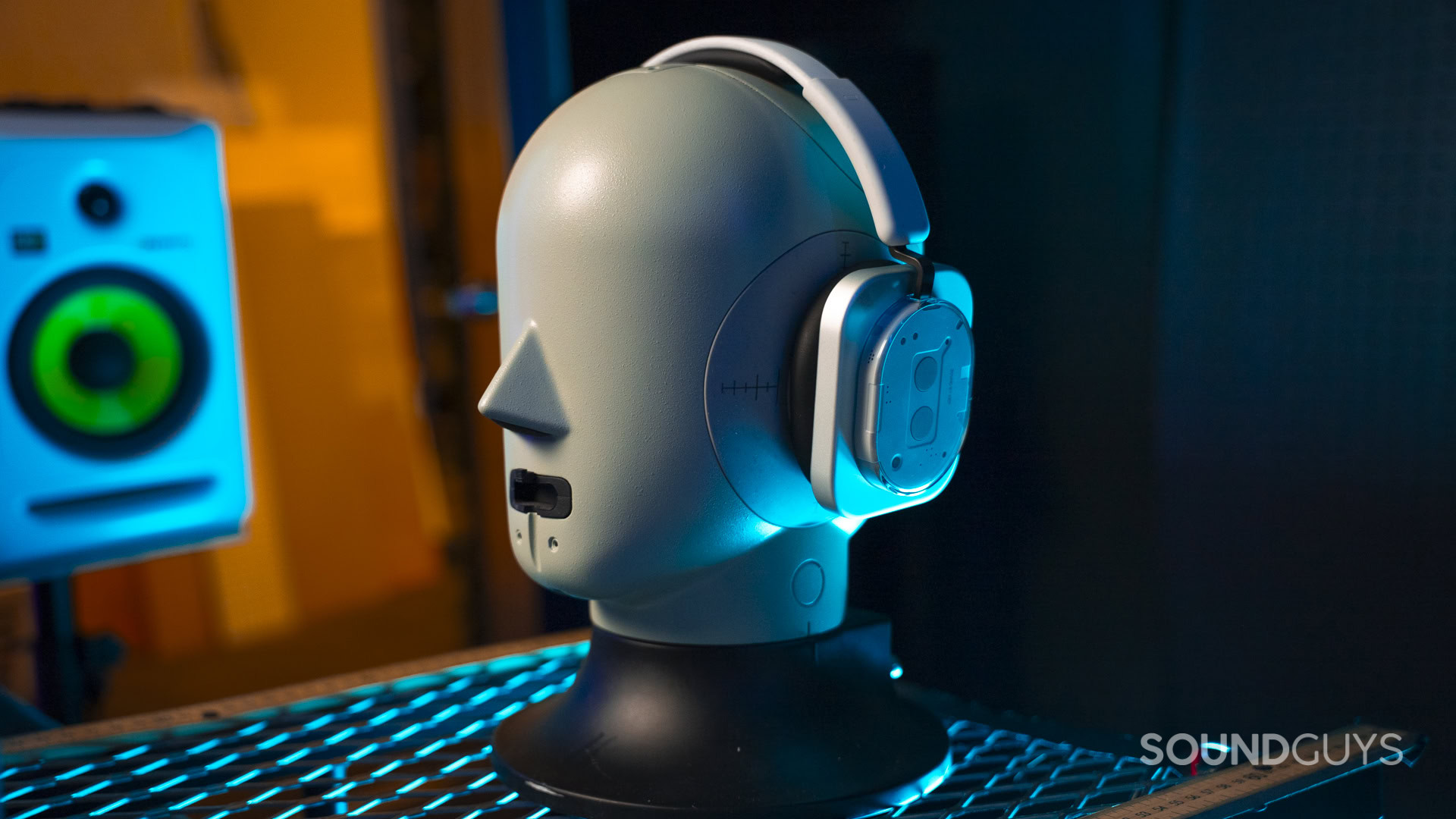
The Nothing headphones (1) house 40mm dynamic drivers in each ear cup that have been engineered and tuned in partnership with KEF. Testing the default EQ preset with familiar tracks revealed a dark sound signature. Overall, these headphones sound good, just not great out of the box. Still, the issues I noticed can be addressed with some EQ tweaking.
Reviewer’s notes
Editor’s note: this review uses a hover-enabled glossary to describe sound quality based on a consensus vocabulary. You can read about it here.
These are the adjustments we made to the Nothing Headphone (1), which I found improve midrange presence and treble strength, helping restore natural vocal clarity and overall balance. It also reduces some of the low-end boominess to achieve a cleaner, more neutral sound.
That said, there are still minor limitations. There’s a bump around 100Hz that retains a bit too much bass strength we couldn’t fully dial back, and some unevenness in the treble region that was difficult to smooth out completely. Even so, this EQ comes as close as possible to our house curve and delivers a more natural listening experience, at least to our ears.
Objective Measurements
Looking at the frequency response measurement against our house curve, the default sound of the Nothing Headphone (1) shows some notable deviations from our target.
Loading chart ...
The low-end tracks our curve fairly well from 20Hz to around 200Hz, with only minor deviations of 1-2dB. The headphones have good bass depth that doesn’t overwhelm the mix. The more significant issues appear in the midrange, where the headphones underemphasize frequencies between roughly 200Hz and 500Hz by about 3-4dB below our target. This weak midrange strength can reduce the presence of vocals and instruments, making them sound distant.
The treble response shows consistent underemphasis across the entire region compared to our house curve. This weak treble strength throughout the upper frequencies will reduce brilliance and make the overall sound less bright than artists may have intended. There’s also a significant roll-off above 8kHz that can make cymbals, hi-hats, and other high-frequency details sound muffled.
- Read our deep dive into how all the EQ presets sound for the Nothing Headphone (1).
Loading chart ...
Yes, but only slightly. Our measurements show the frequency response changes primarily in the lower frequencies below 700Hz when ANC is enabled, mainly a modest increase in bass emphasis, which can make kick drums and bass lines sound more prominent.
Multi-Dimensional Audio Quality Scores (MDAQS)
The chart below shows how the Multi-Dimensional Audio Quality Score (MDAQS) algorithm from HEAD acoustics assesses the sound of the Nothing Headphones (1). The sound quality is rated on a scale from 1.0 (very bad) to 5.0 (very good).
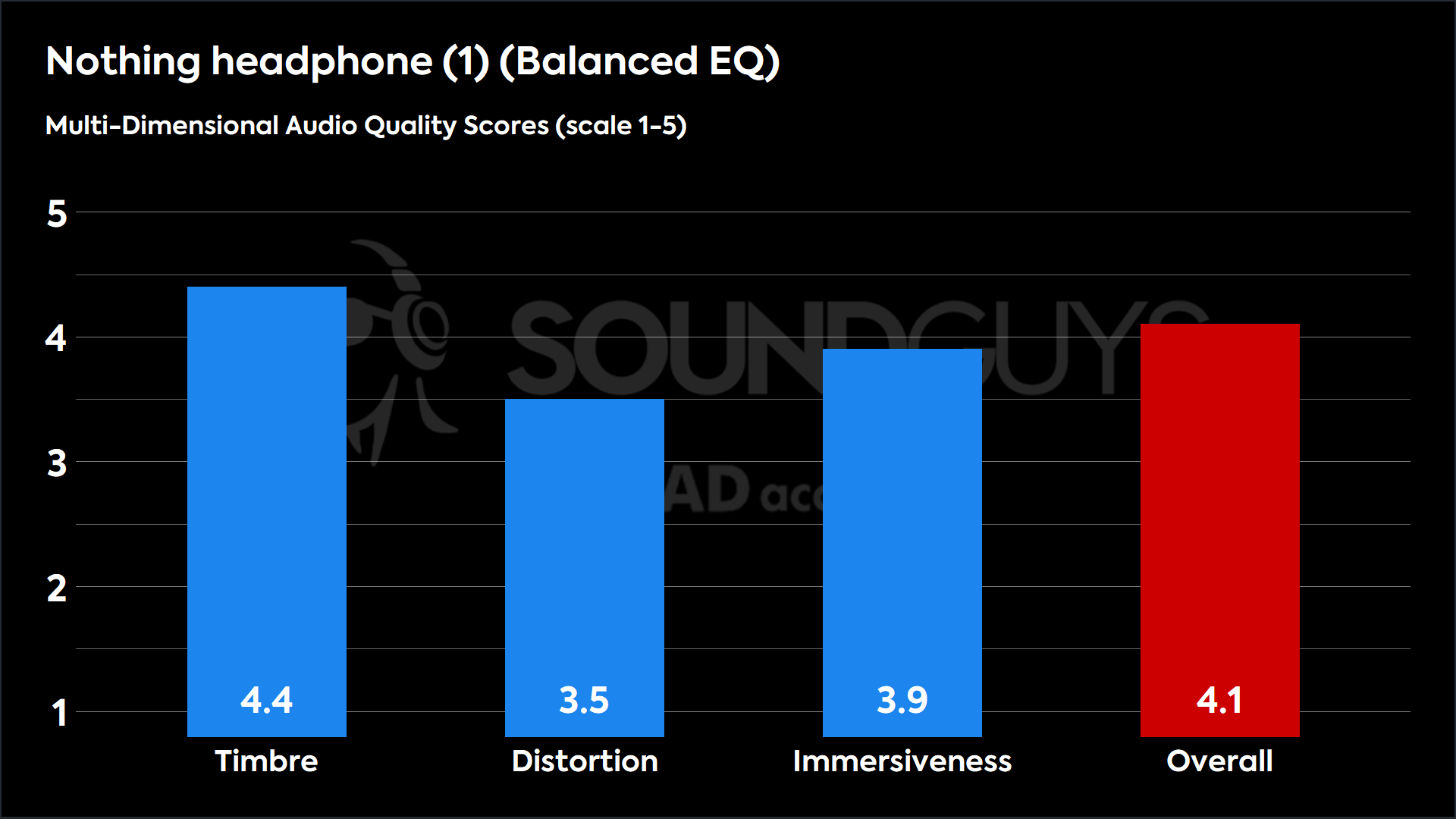
Looking at the MDAQS results for the Balanced EQ preset (the default sound), these headphones deliver solid performance that should please most listeners. The overall score of 4.1 out of 5 falls into the “good” category, indicating that a large group of untrained listeners would generally enjoy the sound quality of these headphones.
The Headphone (1) does best in timbre with a 4.4 rating, meaning instruments and voices sound natural and well-defined. The immersiveness score of 3.9 indicates good spatial positioning and soundstage width, creating a reasonably engaging listening experience where you can distinguish different elements in a mix. The distortion score of 3.5 is the weakest link, though it’s still in “fair” territory and not something you will likely notice unless listening at high volumes.
- Timbre (MOS-T) represents how faithfully the headphones reproduce the frequency spectrum and temporal resolution (timing information).
- Distortion (MOS-D) represents non-linearities and added noise: higher scores mean cleaner reproduction.
- Immersiveness (MOS-I) represents perceived source width and positioning: how well virtual sound sources are defined in three-dimensional space.
Can you use the Nothing Headphones (1) for phone calls?
The Nothing Headphone (1) delivers solid microphone performance that handles most real-world scenarios well. Under ideal conditions, the four-microphone array with AI-powered Clear Voice Technology produces clean, intelligible speech that’s perfectly suitable for calls and video conferences, with strong suppression of background noise.
Nothing Headphones (1) microphone demo (Ideal conditions):
How does the microphone sound to you?
Nothing Headphones (1) microphone demo (Office conditions):
Nothing Headphones (1) microphone demo (Street conditions):
Nothing Headphones (1) microphone demo (Windy conditions):
Nothing Headphones (1) microphone demo (Reverberant space):
Wind noise and droning sounds like air conditioners, traffic rumble, or computer fans are effectively suppressed, allowing your voice to come through clearly even in challenging environments. This makes the headphones reliable for outdoor calls or noisy office settings where steady background noise typically interferes with communication. However, the mic system struggles significantly with echo and reverberation. In rooms with hard surfaces or poor acoustic treatment, the microphone picks up reflections that create a hollow, distant sound quality that can make conversations feel less natural.
Should you buy the Nothing Headphones (1)?

The Nothing Headphone (1) is a bold first step into the over-ear market, and for the most part, it sticks the landing. Its retro-futuristic design turns heads, while practical features like IP52 water resistance and a tactile control system give it real-world appeal. Add in a long battery life, robust ANC performance, and a feature-rich companion app, and you’ve got a package that easily competes with Sony, Bose, and Apple in many areas. However, the default sound requires EQ tinkering to bring out the best in these cans, which might frustrate those who prefer a plug-and-play experience.
If you value style, customization, and durability, the Nothing Headphone (1) offers something genuinely different in a crowded field. Just know that they ask you to meet them halfway: the unique design won’t be for everyone, and the sound tuning needs work out of the box. For audiophiles or those unwilling to experiment with EQ, Sony’s WH-1000XM6 or Bose QuietComfort Ultra may still be safer bets. But for tinkerers and trendsetters, Nothing’s debut is a compelling, if imperfect, alternative at a competitive price.


Nothing Headphones (1) review: FAQs
Yes, the Nothing Headphone (1) are excellent for working out thanks to their IP52 water and dust resistance rating. They can handle sweat, light rain, and gym conditions without damage. The secure clamping force keeps them in place during movement, though the 329g weight might feel heavy during intense cardio sessions.
Yes, you can listen to music with the Nothing Headphone (1) while they are charging.
The Nothing Headphone (1) don't have dedicated Dolby Atmos support, but they do feature native spatial audio with head tracking that can transform stereo content into immersive surround sound. This works well for movies and gaming, though it's less beneficial for music.
The Nothing Headphone (1) work well for gaming thanks to the low-latency gaming mode in the Nothing X app that reduces audio delay. The spatial audio feature can enhance immersion in supported games, and the long battery life means extended gaming sessions won't be interrupted by charging.
Nothing doesn't offer official replacement ear cups for the Headphone (1) at launch.
Thank you for being part of our community. Read our Comment Policy before posting.